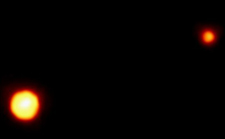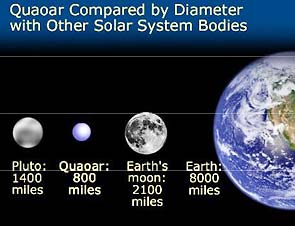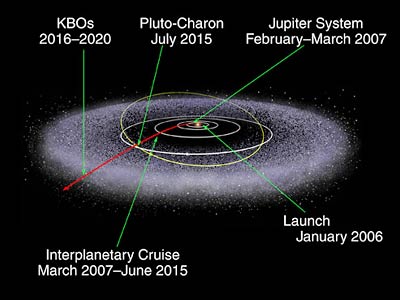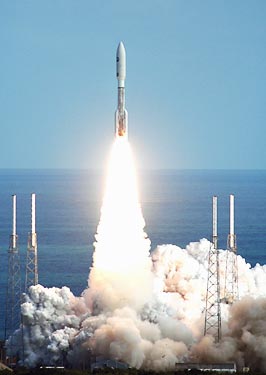Planet Pluto Goes Poof
Pluto—now reclassified as a “dwarf planet”—was discovered after American astronomer Percival Lowell predicted that a “Planet X” was perturbing the orbits of Uranus and Neptune. Lowell searched in vain. After he had died, the self-taught Clyde Tombaugh in 1929 used a 13” telescope to systematically photograph the part of the sky where the planets are seen, with a repeat exposure a few days later, over the course of a year. By comparing the two matching photographic plates, he could distinguish moving objects from the fixed stars. (In fact, Tombaugh’s method relied on the relative motion of Earth and Pluto; for more information, and to see the “discovery image” of Pluto, see the first link.) After checking the positions of more than a million stars, and eliminating a number of asteroids, he found the new planet.

The “discovery image” of Charon. In 1978, astronomer James Christy of the U.S. Naval Observatory noticed that Pluto’s images showed a pattern of elongation, and after further investigation, Christy concluded that Pluto has a moon. The second and third moons were observed by the Hubble Space Telescope in 2005. (Photo credit: U.S. Naval Observatory)

Pluto and Charon, as imaged by the Hubble Space Telescope. (image credit: R. Albrecht (ESA/ESO), NASA)

Some solar system objects and their diameters; for comparison, the diameter of Mercury is about 3000 miles. (image credit: NASA)
The mass of Pluto was found by combining the expression for the acceleration in circular motion, Newton’s second law, and the expression for the gravitational force. The result gives Pluto’s mass in terms of the period of Charon’s orbital motion, the gravitational constant, and the ratio of the masses of Pluto and Charon. (This ratio is involved because the mass of Charon is significant.).
Pluto’s small size created a problem, even then. Through a good telescope, Pluto appeared to be only a point of light, rather than a disk, so the newly-discovered object had to be small—too small, in the opinion of many astronomers, to have caused the orbital perturbations that had motivated the search for it. With no way to measure the mass of this distant object, the issue could not be settled. Many decades later, in 1978, Pluto’s large moon Charon was found—see the photos—and its period and orbital radius led to an estimation of Pluto’s mass. (See sidebar.) The mass of Pluto is about one five-hundredth the mass of Earth, too small to have perturbed the orbits of Uranus and Neptune, so Pluto was not the “Planet X” that Lowell had sought.
Besides its small mass, Pluto’s orbit sets it apart. The orbit is highly elliptical and tilted at 17 degrees to the ecliptic plane (where the planets move). For about 20 years of its 249-year period, it is closer to the sun than Neptune. Also, Pluto’s axis is tilted at 112 degrees to the ecliptic plane (Earth’s axis is tilted only 23.5 degrees.)
Pluto is by no means at the edge of the solar system. At this scale, it’s convenient to use the Astronomical Unit (AU), with 1 AU defined to be the radius of Earth’s orbit. Pluto’s orbit is about 39 AU from the sun. Most long-period comets, at their greatest distance from the Sun (apehelion), are about 50,000 to 100,000 AU away, a range that extends a quarter of the way to the nearest star. In 1950, the Dutch astronomer Jan Oort hypothesized a huge cloud of comets at this region. Small objects at this immense distance cannot be observed from Earth, so Oort’s cloud remains a hypothesis.
If long-period comets come from the Oort Cloud, how about the short-period ones? In 1950, Gerald Kuiper proposed that large numbers of small icy objects occupy what came to be called the Kuiper Belt, which, unlike the vastly distant Oort Cloud, extends from about 30 AU to 50 AU. The orbit of Pluto falls about in the middle of the Kuiper Belt, and some astronomers consider Pluto and its moons to be Kuiper Belt Objects (KBOs).
KBOs are close enough to be observed with Earth-based telescopes. In 1992 the first one was found, and more than 1,000 have now been identified. One of the largest is Quaoar (see drawing), which orbits at about 42 AU and is about as large as Pluto’s moon Charon. Several larger KBOs have been discovered since.
In 2003, an object was discovered in the solar system with a mass greater than Pluto’s (although only slightly). This was Eris (the object formerly known as Xena), whose highly eccentric orbit ranges from 38 AU to 97 AU from the sun. So Pluto found itself in a neighborhood with similar-sized objects, and it was not even the largest of those.
Research
In 2000, even before Eris had appeared on the scene, the American Museum of Natural History’s Hayden Planetarium opened a new exhibit on the eight planets—Pluto was prominently excluded. The rest is history. In August of 2006, the International Astronomical Union (IAU) redefined “planet” as follows.
- The object must be in orbit around the Sun.
- The object must be large enough that it is nearly round (i.e., is in hydrostatic equilibrium).
- The object must have cleared its orbit of other objects.

The trajectory of the New Horizons probe to Pluto. (image credit: JHU/APL)
The “orbit the sun” requirement eliminates moons, such as the large moons of Jupiter.
The “nearly round” requirement eliminates small objects whose gravity is not strong enough to overcome the forces between the rocks or ices and produce a spherical surface, which has the lowest gravitational energy.
The “clear its orbit” requirement is equivalent to saying that a planet is much larger than anything else around, in which case its relatively strong gravity would indeed sweep up the neighboring objects. In fact, Ceres and a few other asteroids were originally classified as planets, before astronomers realized that they are all part of a large collection of objects with similar orbits.
The IAU also created a new category, “dwarf planet,” for those objects that meet the first two requirements above but have not cleared their neighborhood of other objects. Pluto falls into this category because of various Kuiper Belt Objects in its neighborhood. Along with Pluto, the dwarf planet category includes Eris and Ceres.
Whatever issues still remain about Pluto’s status, it is an important object in the solar system and is the subject of study, although no probe has yet reached it. In January 2006 the New Horizons spacecraft blasted off for the long voyage to Pluto (see drawing of trajectory), with the closest approach in July, 2015, at a distance of 10,300 km (6200 mi).
Links
The Planetary Society

The launch of the New Horizons spacecraft, which will arrive at Pluto in 2015. (photo credit: NASA/KSC)
CalTech
BBC
- Pluto loses status as a planet (with diagram of the new solar system)
Johns Hopkins University Applied Physics Lab














